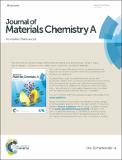Files in this item
Room temperature demonstration of a sodium superionic conductor with grain conductivity in excess of 0.01 S cm-1 and its primary applications in symmetric battery cells
Item metadata
| dc.contributor.author | Ma, Qianli | |
| dc.contributor.author | Tsai, Chih-Long | |
| dc.contributor.author | Wei, Xian-kui | |
| dc.contributor.author | Heggen, Marc | |
| dc.contributor.author | Tietz, Frank | |
| dc.contributor.author | Irvine, John | |
| dc.date.accessioned | 2020-02-25T11:57:59Z | |
| dc.date.available | 2020-02-25T11:57:59Z | |
| dc.date.issued | 2019-02-25 | |
| dc.identifier | 257990487 | |
| dc.identifier | ab348bcb-d5a5-41cc-bc1a-06eee62afa1f | |
| dc.identifier | 85063538692 | |
| dc.identifier | 000463819400048 | |
| dc.identifier.citation | Ma , Q , Tsai , C-L , Wei , X , Heggen , M , Tietz , F & Irvine , J 2019 , ' Room temperature demonstration of a sodium superionic conductor with grain conductivity in excess of 0.01 S cm -1 and its primary applications in symmetric battery cells ' , Journal of Materials Chemistry A . https://doi.org/10.1039/C9TA00048H | en |
| dc.identifier.issn | 2050-7488 | |
| dc.identifier.other | RIS: urn:4CCF9B5DB6049E28E46E958F159AD9FF | |
| dc.identifier.other | ORCID: /0000-0002-8394-3359/work/68280711 | |
| dc.identifier.uri | https://hdl.handle.net/10023/19527 | |
| dc.description | Partial financial support from the German Federal Ministry of Education and Research (BMBF) in the frame of the BenchBatt project (reference number 03XP0047B) is gratefully acknowledged. | en |
| dc.description.abstract | The lack of suitable candidate electrolyte materials for practical application limits development of all-solid-state Na-ion batteries. Na3+xZr2Si2+xP1-xO12 were the very first series of NASICONs discovered some 40 years ago; however, separation of bulk conductivity from total conductivity at room temperature is still problematic. It has been suggested that the effective Na-ion conductivity is ~10-4 S cm-1 at room temperature for Na3+xZr2Si2+xP1-xO12 ceramics; however using solution-assisted solid-state reaction for preparation of Na3+xZr2Si2+xP1-xO12, total conductivity of 5 × 10-3 S cm-1 was achieved for Na3.4Zr2Si2.4P0.6O12 at 25 °C, higher than previously reported for polycrystalline Na-ion conductors. Bulk conductivity of 1.5 × 10-2 S cm-1 was revealed by high frequency impedance spectroscopy (up to 3 GHz) and verified by low temperature impedance spectroscopy (down to -100 °C) for Na3.4Zr2Si2.4P0.6O12 at 25 °C, indicating further potential of increasing the related total conductivity. A Na/Na3.4Zr2Si2.4P0.6O12/Na symmetric cell showed low interface resistance and high cycling stability at room temperature. A full-ceramic cell was fabricated and tested at 28 °C with good cycling performance. | |
| dc.format.extent | 11 | |
| dc.format.extent | 1721691 | |
| dc.language.iso | eng | |
| dc.relation.ispartof | Journal of Materials Chemistry A | en |
| dc.subject | QD Chemistry | en |
| dc.subject | NDAS | en |
| dc.subject.lcc | QD | en |
| dc.title | Room temperature demonstration of a sodium superionic conductor with grain conductivity in excess of 0.01 S cm-1 and its primary applications in symmetric battery cells | en |
| dc.type | Journal article | en |
| dc.contributor.institution | University of St Andrews. Centre for Designer Quantum Materials | en |
| dc.contributor.institution | University of St Andrews. School of Chemistry | en |
| dc.contributor.institution | University of St Andrews. EaSTCHEM | en |
| dc.identifier.doi | 10.1039/C9TA00048H | |
| dc.description.status | Peer reviewed | en |
| dc.date.embargoedUntil | 2020-02-25 |
This item appears in the following Collection(s)
Items in the St Andrews Research Repository are protected by copyright, with all rights reserved, unless otherwise indicated.

